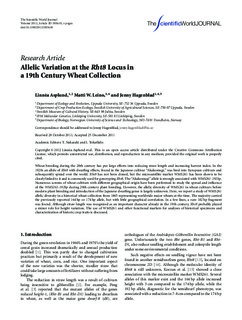| dc.contributor.author | Asplund, Linnéa | |
| dc.contributor.author | Leino, Matti | |
| dc.contributor.author | Hagenblad, Jenny | |
| dc.date.accessioned | 2019-10-15T06:43:23Z | |
| dc.date.available | 2019-10-15T06:43:23Z | |
| dc.date.created | 2012-09-19T14:39:22Z | |
| dc.date.issued | 2012 | |
| dc.identifier.citation | Scientific World Journal. 2012:385610. | nb_NO |
| dc.identifier.issn | 1537-744X | |
| dc.identifier.uri | http://hdl.handle.net/11250/2622108 | |
| dc.description.abstract | Wheat breeding during the 20th century has put large efforts into reducing straw length and increasing harvest index. In the 1920s an allele of Rht8 with dwarfing effects, found in the Japanese cultivar “Akakomugi,” was bred into European cultivars and subsequently spread over the world. Rht8 has not been cloned, but the microsatellite marker WMS261 has been shown to be closely linked to it and is commonly used for genotyping Rht8. The “Akakomugi” allele is strongly associated with WMS261-192bp. Numerous screens of wheat cultivars with different geographical origin have been performed to study the spread and influence of the WMS261-192bp during 20th century plant breeding. However, the allelic diversity of WMS261 in wheat cultivars before modern plant breeding and introduction of the Japanese dwarfing genes is largely unknown. Here, we report a study of WMS261 allelic diversity in a historical wheat collection from 1865 representing worldwide major wheats at the time. The majority carried the previously reported 164 bp or 174 bp allele, but with little geographical correlation. In a few lines, a rare 182 bp fragment was found. Although straw length was recognized as an important character already in the 19th century, Rht8 probably played a minor role for height variation. The use of WMS261 and other functional markers for analyses of historical specimens and characterization of historic crop traits is discussed. | nb_NO |
| dc.language.iso | eng | nb_NO |
| dc.publisher | Hindawi | nb_NO |
| dc.rights | Navngivelse 4.0 Internasjonal | * |
| dc.rights.uri | http://creativecommons.org/licenses/by/4.0/deed.no | * |
| dc.title | Allelic Variation at the Rht8 Locus in a 19th Century Wheat Collection | nb_NO |
| dc.type | Journal article | nb_NO |
| dc.type | Peer reviewed | nb_NO |
| dc.description.version | publishedVersion | nb_NO |
| dc.source.pagenumber | 6 | nb_NO |
| dc.source.journal | Scientific World Journal | nb_NO |
| dc.identifier.doi | 10.1100/2012/385610 | |
| dc.identifier.cristin | 945030 | |
| dc.description.localcode | Copyright © 2012 Linnéa Asplund et al. This is an open access article distributed under the Creative Commons Attribution License, which permits unrestricted use, distribution, and reproduction in any medium, provided the original work is properly cited. | nb_NO |
| cristin.unitcode | 194,66,10,0 | |
| cristin.unitname | Institutt for biologi | |
| cristin.ispublished | true | |
| cristin.fulltext | original | |
| cristin.qualitycode | 1 | |

